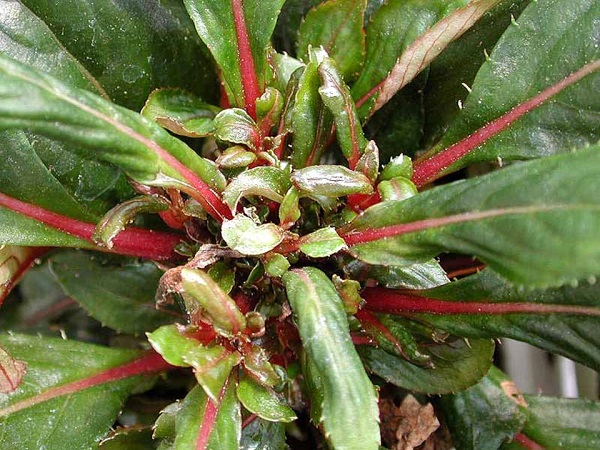Cyclamen Mite in the Greenhouse
ENTFACT-422: Cyclamen Mite in the Greenhouse | Download PDF
by Ric Bessin, Extension Specialist
University of Kentucky College of Agriculture
Mites are sap-sucking pests that attack a wide range of greenhouse plants. Two species, the two-spotted spider mite and the cyclamen mite, can cause serious, persistent problems. Both of these mites feed by piercing tissue with their mouthparts and sucking out cell contents. While most greenhouse operators recognize the two-spotted spider mite and understand how to manage it, the cyclamen mite remains a mystery to many. This factsheet describes the biology and management of cyclamen mites.
Damage
Because of their small size, cyclamen mites often go undetected until the damage becomes severe. Usually it is the nature of the injury, not the mites themselves, that alerts greenhouse managers to cyclamen mite infestations. Depending on the type of plant attacked, cyclamen mites may infest the entire plant or be concentrated around the buds. Infested leaves become distorted, often curl inward, and foliage may become darker and appear streaked and blotchy. Injured foliage may show purplish areas. Very small, white, green, or pale-orange mites, with six or eight legs, work about the base of the plants or in the buds or the injured areas on the leaves. These mites thrive when the temperature is around 60°F and can complete their life cycle in about 2 weeks.

Figure 1. Cyclamen mite damage to New Guinea impatiens.
African violets, cyclamen, dahlia, gloxinia, snapdragon, geranium, chrysanthemum, larkspur, begonia, fuchsia, petunia, and New Guinea impatiens are highly susceptible to cyclamen mites, however, cyclamen is injured more than any other plant. This mite is also a pest of strawberry, out-of-doors. This is an introduced species that was first recorded in New York in 1898. It is now generally distributed in greenhouses throughout the country.
Biology
Adult cyclamen mites are minute, elliptical, semi-transparent, orange-pink and shiny, with eight legs. They are about 1/100 inch long and cannot be seen without magnification. The hind pair of legs in the female is threadlike, and those of the male are pincer-like. The eggs are laid about the base of the cyclamen plant and in injured areas of the leaves and on strawberries along the midribs of the unfolding leaves. Each female deposits about 90 eggs, of which 80 percent may develop into females. The mites develop through a six-legged larval stage and a dormant nymphal stage with eight legs. All stages of the mite are found on infested plants. Out-of-doors, the adult female overwinters in protected locations around the crown of the strawberry plant.
Management
Great care should be taken to avoid spreading this pest in the greenhouse. Mites can easily be moved from infested to noninfested plants on hands and clothing, so always examine infested benches and other hot spots for symptoms of mite infestation last during greenhouse inspections. Infested plants may be treated by immersion in water to 110°F for 15 to 30 minutes. Badly injured plant parts should be trimmed off where practical before dipping. The infested plant, pot and all, is immersed in the water. Success of the treatment depends on careful control of the water temperature.
Often, it is better to discard infested plants than to attempt to control the problem with pesticides. If chemical control is attempted, isolate the infested plants to reduce potential spread of the mites. Spraying the plants with insecticidal soap can provide effective control, especially after pruning back the growth. Three to four applications should be made at 3 to 5 day intervals with insecticidal soap. No wetting agent is needed. Direct applications at both the lower and upper leaf surfaces. Stocks of susceptible plants should be sprayed before cuttings are taken, and infested plants should be destroyed immediately.
Several species of mite predators are commercially available. These are usually released when mites first appear and should be evenly dispersed throughout the greenhouse. If mite infestations are heavy, consider spraying with an insecticidal soap before releasing predator mites. Selection of the proper predatory mite species will depend on greenhouse temperatures and humidity. If predatory mites are used, early release at the first sign of mite infestation is critical. Unlike the use of a miticide, it will take some time for predatory mites to control infestations.
See ENTFact-125, Vendors of Beneficial Organisms in North America, for a list of predatory mites and suppliers.
Revised: 11/19
CAUTION! Pesticide recommendations in this publication are registered for use in Kentucky, USA ONLY! The use of some products may not be legal in your state or country. Please check with your local county agent or regulatory official before using any pesticide mentioned in this publication.
Of course, ALWAYS READ AND FOLLOW LABEL DIRECTIONS FOR SAFE USE OF ANY PESTICIDE!
Images: University of Kentucky Entomology.
